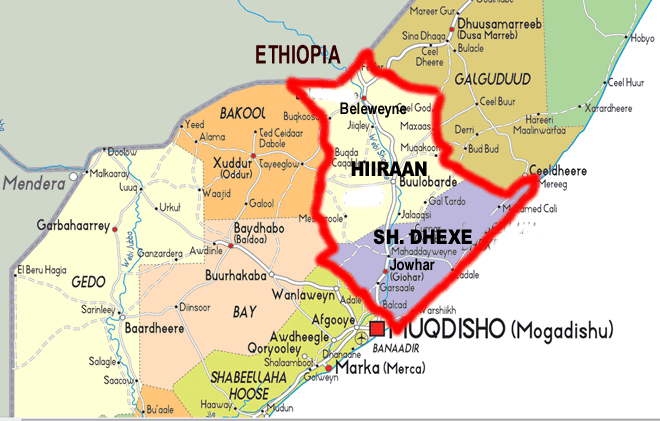
The recent Galmudug presidential election has been a major breakthrough for the central government which is attempting to implement a federalism system across Somalia.
Overcoming the challenges of the State Formation process has been a major test for the Federal government which in effect has completed the process now with the holding of a transparent election in which voters elected a new president. This is a rare attainment by the Somali people as the entire process was initiated and completed by Somalis without any outside support.
Having completed the mission in Galmudug, Somalia’s government is now going to embark on a similar one: the formation of an administration for the neighboring Hiiraan and Middle Shabelle regions.
Somalia’s interior Minister Abdirahman Mohamed Hussein has unveiled the new plan though he has yet to provide more details on the scheme.
Despite the new political exercise, there have been no consensus from clans who inhabit the two regions to integrate their regions to form their own administration. In addition to that, political analysts predict further political challenges moving ahead with the decision of forming the proposed administration at the present time due to clans mistrusts and rivalry.
Legislators from Hiiraan region have recently opposed the government’s plans to unite the two regions, warning the scenario would further polarize the two regions along clan lines.
In a decree issued by the former Somali president Sheikh Sharif Sheikh Ahmed, he stated that Hiiran region would solely come under the control of the government, dismissing suggestions that it should be merged with Middle Shabelle region.
Some of the key political arguments being raised by politicians from the regions include which region would be the regional capital if the two regions were merged as one state and how the two sides would share the government.
The apparent political rivalry would further chip away at the government’s efforts to bring the two sides to the table to neutralize their political differences.
The two regions’ clans unambiguously have clear interests in certain political outcomes and agreement thus far seems unlikely on their part to form an administration.
Reflecting on the apparent challenges, observers believe forming an administration for the two regions at this time would promote the creation of more autonomous regions operating outside the government’s control, a development that may perhaps reverse recent security and political gains by the government.
Autonomous region of Hiiraan and Middle Shabelle enjoy abundant natural resources in agricultural land, livestock and fishing industry. Despite the abundant resources, the Somali Government has an uphill struggle to convince the tribal leaders of those supposed to share the newly proposed region that unity is in their best interests.
No comments:
Post a Comment